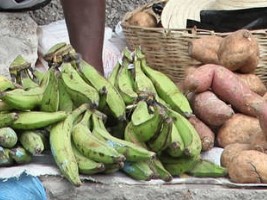|
||||||||||||||||||
|
|
Haiti - Economy : Limited products and sharp increase in market prices 12/12/2016 10:18:33
Report Summary : General constraints to market functioning :
Availability of food items in the markets : In all markets, the availability of local products is low. Due to the hurricane hitting at the height of the banana, bean and yam harvest, these crucial seasonal products are critically low in supply, especially in the markets of the Grande-Anse. The products available in the markets at this moment are imported products, such as rice or maize. In addition to the lack of availability of local products, the hurricane also destroyed a significant share of the food stocks in local warehouses. Most markets, especially those accessible by marine transport, are able to respond to a surge in demand with a delay of one or two weeks. The products presently available as well as those shipped in will be imported from abroad. The destruction of transport routes, poses a significant problem in delivery of goods to some markets, especially inland markets. A critical obstacle for many traders is the lack of access to credit for purchasing supplies in bulk, added to the scarcity of available goods. Consumer Demand for Products in the Markets : Demand for commodities fell sharply in almost all markets for three main reasons according to traders: 1) Lower consumer purchasing power due to plantation destruction and crop loss; (2) Rising commodity prices (maize and rice); 3) availability of in-kind food assistance to offset market shortfalls. Price Developments Food item prices have risen in all markets since the hurricane. Generally the price increase range from 15 to 25% for main staple food items throughout October. The use of alternative transport routes or means are probably reflected in higher market prices. Markets in the Grande-Anse Department have suffered most from the price increases, while in the Nippes and Sud Departments the upward tendencies are much more moderate if at all visible in some markets. Therefore, starting in November, the prices seem to return to pre-Matthew levels, which increases the accessibility to food. Feasibility/Appropriateness of a Cash based transfer (CBT) : From the analysis of the availability of goods in the markets, a Cash-based transfer is a feasible response. The most salient risk in a CBT response is price volatility, which could lead to a sudden erosion of beneficiaries’ purchasing power. If CBT is implemented, the increasing demand for food will have an impact on the markets and trading opportunities. This impact, particularly on the prices, must be monitored on a weekly basis, so that the transfer value guarantees a stable purchasing power. On the traders’ side, concerns with CBT are mostly linked to their constraints to ensure a reliable supply of food, notably, their lack of a steady cash flow and lack of access to credit to replenish stock. A complementary programme that supports local traders in terms of access to credit and wholesale markets could address the cash flow issue. A mixed review is given by traders on the feasibility of a voucher programme, which seems to have been less than beneficial for some traders in the past and complicated to manage. Given this constraint, it is advisable to start by default, with an unrestricted Cash-Based Transfer, which can be effected over a mobile money provider. For beneficiaries, an unrestricted cash transfer could have wider positive effects than just food security, as it gives them flexibility to use the cash to restore livelihoods. A midline post-distribution monitoring exercise should be conducted to examine beneficiary consumption patterns and give preliminary assurance that the cash is having a positive impact on food security. General Conclusions and Recommendations : High food prices are the principal concern for a cash-based transfer in the hurricane-affected departments. Based on the analysis of the prices as of the end of October, a locally purchasable food basket of 250g Rice, 100g Maize, 80g Black Beans, and 50g Vegetable Oil, costs between 29-32 Gourdes in the markets of Les Cayes and Miragoane, and 32-37 Gourdes in the markets of Jeremie. A daily transfer value of 30-35 Gourdes per person would therefore be appropriate to cover the food needs of the population. It is important to monitor the development of prices of an average food basket for some key locations in the three departments. The cash transfer value could be adjusted accordingly as markets recover from the surge prices seen at the moment. In November, food prices in Grand-Anse and Sud departments already seem to show downward tendencies. A cash transfer programme could help beneficiaries focus on restoring their livelihoods and prepare their land for the coming planting and harvest seasons. The emergency food security survey being undertaken by CNSA and its partners and for which results will be available end of December should help follow the evolution of consumption in the area and further adjust cash and vouchers programs being implemented in these areas. HL/ HaitiLibre
|
|
|
Why HaitiLibre ? |
Contact us |
Français
Copyright © 2010 - 2024 Haitilibre.com |



